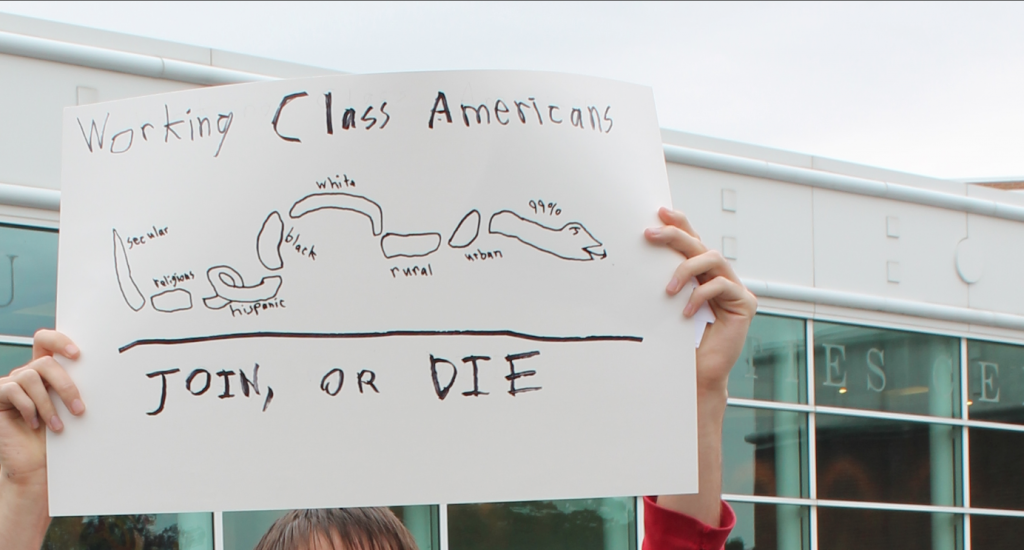Like the group occupying Wall Street in New York, members of Occupy Stony Brook stood in the center of a large plaza, demanding attention to their cause.
But instead of being surrounded by greedy bankers, Occupy Stony Brook was competing for attention with students who were protesting domestic violence – and weren’t thrilled about the occupiers’ presence.
When asked why the occupiers were in the Student Activities Center plaza, what they were protesting and where (if anywhere) they planned to occupy, Lauren, a protestor who asked to only be identified by her first name in case the group ever got into trouble, said “the group doesn’t have any plans.”
It’s been decades since Stony Brook University has been the hotbed of activism that was referred to as the Berkley of the East, and many have complained that the student body has become too apathetic. Some movements, such as SlutWalk and one opposed to the building of a hotel on campus, have gained plenty of traction in the last couple of years, but Occupy Stony Brook and the Tea Party, two of the largest and most enthusiastic movements on a national level, have failed to take hold at Stony Brook.
While the two clubs have extremely different political views and focus on shared services, they have both behaved similarly to each other at some points and to their namesakes at others.
The Stony Brook Tea Party, headed by Kevin Sabella, gained notoriety for asking long, provocative questions at a political assembly, much in the same way members of the Tea Party did in town halls nation wide.
Sabella, a transfer student from Nassau Community College, spent much of last fall posting flyers around campus for his Tea Party before finally receiving campus media attention when he stood up during a lecture by Arianna Huffington. He struggled to expand his ranks last year, but eventually grew his club with friends from the Young Americans for Freedom and the College Republicans.
Sabella admits to not having seen much more of Occupy Stony Brook than their advertisements, but has a number of criticisms for the national movement.
“If you’re complaining that [banks are] being given government subsidies, why not just blame the government?” he asked.
“They’re not lobbying, not organizing for elections; they’re only screaming into a bullhorn and that’s only going to get you so far,” he said, mentioning that he and other conservative activists at Stony Brook have volunteered on political campaigns.
Occupy Stony Brook is comprised of some members of the Radical Student Union, along with “most of the people [from SBU] who attended Wall Street,” according to occupier Roger Palomeque.
Rather than trying to work within the system like Sabella, Occupy Stony Brook does its best to work around it. When a campus police officer told them that they couldn’t have a table in the SAC plaza, all six of the occupiers picked up the table and stayed put.
“It’s not a table anymore because it doesn’t have legs,” Lauren said.
Palomeque even suggested the goal of their protests should be to drastically change the system. “It’s imperative not to focus on particular issues and not reforms,” he said, saying that no reform could go far enough.
Even though both groups have a strong focus on the university, they’ve had trouble attracting the campus’ interest as much as other grassroots protests on campus have.
Lauren believes that students will want to join Occupy Stony Brook once they become aware of its existence. Similarly, Sabella attributes the small turnout at his meetings to scheduling conflicts, claiming that more people want to be involved.
Like protesters at Wall Street, no one from Occupy Stony Brook was willing to speak on behalf of the group, but NYSUNY 2020 and its tuition increases seemed to be a major point of contention for the group.
Shared services, a combining of department’s administrative staffs to balance workloads and increase efficiency, has also drawn the ire of the occupiers. “The demand we have is stopping [privatization],” said Lauren.
Sabella looks at shared services quite differently.
“With tuition increases, what is the campus doing to save money instead of burning money?” he asked. He believes that tuition, like taxes, should remain low and that the cuts being made to Stony Brook on an administrative level are a good idea.
“In Nassau, I had to take calls for both the history and the political sciences department,” he said, adding that the system worked well there.
With Stony Brook implementing shared services and with a presidential election just a year away, both groups can be expected to remain active on campus. But to what extent they can gain momentum is, at this point, still unclear.

